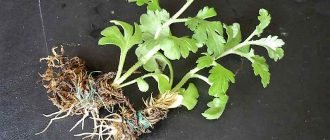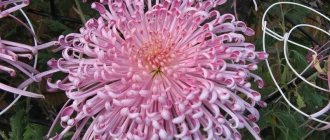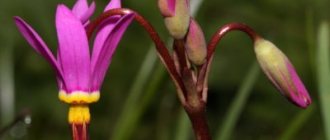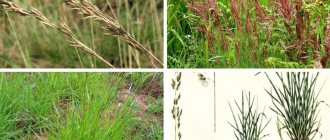Caring for chrysanthemums
As you know, there are a lot of varieties of chrysanthemums. There are basically two types of chrysanthemums. These are large-flowered. They look very beautiful in bouquets. These flowers love warmth. And therefore they grow either in greenhouses, greenhouses or in the south. Such chrysanthemums are called Indian. The second type of chrysanthemums are Korean. They are grown both in garden plots and in pots as indoor plants.
Their color range is very diverse. These flowers grow in the form of a bush. This is a perennial plant. And another advantage for these flowers is that they tolerate cold days well and are quite frost-resistant. Although it is still better to protect them from the cold for the winter. These plants also attract the attention of flower growers because they are undemanding and quite easy to care for.
If it is decided that the oak chrysanthemum will grow on a plot of land without shelter, then it is necessary to ensure that the plant has:
- enough sunlight
- windless side.
- The soil should be fairly light. Organic fertilizers and sand can lighten the soil if it turns out to be heavy. In airy and loose soil that absorbs water well, the flower will be able to take root faster and easier.
- It is better to use cow humus to feed oak trees.
- Two weeks after planting the flowers, the first fertilizing is done.
- If you want to extend the flowering time of chrysanthemums, you can use phosphorus fertilizers. By the way, this will make the leaves of the plant look greener, stronger and thicker.
- Potassium-phosphorus fertilizers should be fed to flowers during the formation of buds and during the entire flowering of oak trees.
- It is better to do foliar feeding with nitrogen fertilizers.
- When watering, water should not get on the leaves of the flowers.
- For beauty, it is necessary to trim the bushes on time.
Insects can also cause a lot of trouble for these beautiful flowers. To protect such beauty, it is necessary to get rid of aphids. This must be done before the buds form. Meadow bugs and spider mites also spoil oak flowers. Pesticides are suitable for controlling these pests.
In order for the flowers to be able to spend the winter calmly and not freeze, you need to take care of them before the onset of severe frosts. To do this, the garden perennial chrysanthemum must be pruned. And the ground around the bush needs to be hilled up and treated with humic substances. With the onset of frost, the bush is covered with spruce or pine branches. It helps protect the bush from wind and frost. Prevents precipitation. Helps maintain a certain temperature regime. And rodents will not be able to get to the flowers.
If chrysanthemums, such as multiflora growing in a flower bed, are purchased in early autumn, then they should not be replanted. Just a cool room is very suitable for them. Well, it is necessary that the soil in the flower beds be constantly moist.
Chrysanthemums and oaks - what's the difference?
Some flower lovers believe that oak is a separate type of flower. In fact, oak flowers are classified as chrysanthemums.
Chrysanthemums are large-flowered - Indian and small-flowered - Korean. If the former are grown for bouquets, then Korean chrysanthemums are used for garden decoration or for growing in flower pots at home. They look good in group plantings.
Korean chrysanthemums include oaks. They have a strong stem that stands firmly in the wind and are distinguished by long and abundant flowering. Oak can be grown as a small tree up to 1 meter tall.
Reproduction and cultivation of oak trees
The best time to plant or replant flowers is after the last frost and cold weather have passed. The last month of spring, May, is ideal for this event. Even the beginning of June will do. These flowers need to be planted in higher areas.
These flowers can best be propagated using cuttings or in separate parts of the bush, separated from the main bush.
It is necessary to decide on the location and location of the plants. Then prepare the soil. And if you have to plant previously grown cuttings, then it is preferable to transfer the cuttings into the ground together with a lump of earth, so as not to damage the root system of the plant. If the plants in flower beds were kept in a cool place, then they will need to stand in the open air for a week so that they can warm up. Plant small chrysanthemum bushes at a distance of twenty centimeters.
Bush chrysanthemums grow very quickly. Over the course of a season, they grow from a planting cutting to a full-fledged bush. To give the bush a certain shape, you need to carry out shaping. It is necessary to pinch the tops in early June. It is worth replanting large chrysanthemum bushes if they have been growing in the same place for three years. During the first year, after transplanting the bush to a new place, the soil around the bush needs to be loosened constantly throughout the year. This is necessary for flowers, since young shoots will appear faster and the bush itself will form.
It is also possible to replant chrysanthemums in the autumn season, in areas where winters are not cold and there are no severe frosts. In such cases, it is necessary to transplant the cuttings before the first frost. To do this, you need to dig up the plant and cut off the old branches. Then separate the young ones.
Next, you need to prepare the soil by fertilizing it first. There should be no stagnant water in the holes. Then plant young cuttings. And don't forget to water. Over time, we cover the flowers, protecting them from the winter cold. To do this, you can use sawdust, peat, spruce branches, and dry leaves. Large chrysanthemum bushes can also be transplanted into a suitable sized flower pot or bucket, but do not damage the plant and root system. Leave the plant in a cool place. As soon as the flowers begin to fade, it will be necessary to trim the bush almost to the ground, leaving about fifteen centimeters. Leave the plant in this state until spring.
You can also try growing chrysanthemums using seeds. Based on the photo, you can choose exactly those chrysanthemum seeds that you liked best and want to grow at home. To sow chrysanthemum seeds, you need to prepare special boxes with the necessary soil. In February, in its last ten days, or in March, you need to sow flower seeds in special boxes, which must be covered with glass on top.
This way the greenhouse effect is recreated. After seven days, sprouts appear. As soon as two leaves appear on the plant, the flowers must be immediately transplanted into pots. Two months is enough for the plant to grow to a height of up to twenty centimeters. Oak trees bloom five months from the moment they are planted. In May, seedlings are already planted in open ground. To plant a young flower in the ground, you need to choose the right weather.
It could be a cloudy day, or even better, a rainy day. To plant flowers you need to make a trench. It's better than planting in holes. The distance between seedlings can be from twenty to thirty-five centimeters, depending on the type of flowers. After planting and watering the plant, pinching is carried out, that is, the sprouting point of the flower is removed. You can cover the seedlings and keep them covered until you are sure that the flowers have set.
Description and popular varieties of Dubka
Now about 650 species of chrysanthemums are known, grouped into 13 groups according to types of inflorescences . Among them are pompom, feathery, bristly, spherical, anemone-shaped, simple, low-growing, semi-double, double types of plants. Perennial and annual species. One of the conditional groups includes cold-resistant Korean chrysanthemums. The list of varieties of Korean chrysanthemums contains a large number of multi-colored forms, despite the meaning of the word chrysanthemum as “golden-colored.”
Korean chrysanthemums
a Korean chrysanthemum bush can reach 25, 130 cm. The inflorescences are formed from a large number of small flowers or several large ones, reaching 12 cm. The flowers can have the shape of a tube or a tongue. Often up to 400 inflorescences bloom simultaneously on a bush, collected in a complex panicle . The erect stems have fragile branches with numerous leaves. Their upper surface is smooth. The lower part is covered with light hairs. The branched root system, located at a depth of up to 20 cm, has shoots in the form of stolons and numerous shoots.
Terry chrysanthemum
Terry and semi-double varieties have a specific smell, similar to the freshness of autumn fogs, not yet cold rains. If faded inflorescences are promptly removed, the total duration of flower growth on the stems reaches four months. Japan and China are considered the birthplace of oak trees. In Russia, chrysanthemums began to be cultivated as a cultural perennial flower in the middle of the last century. There is evidence that the main set of modern varieties of “Korean hybrids” began as a result of crossing work carried out by A. Cumming in 1928.
It is not recommended to grow any type of oak tree in a specific place for more than five years. The flowers become small. The decorative quality of the inflorescences decreases. Two or three year old bushes withstand winter better.
Domestic breeders offer the following varieties of chrysanthemums that have become popular:
Daisy
Chrysanthemums Daisy
A strong bush, reaching a height of 70 cm, decorated with semi-double inflorescences of white flowers with a diameter of approximately 8 cm. The white color of the petals has a hint of yellow. The leaves are light green in color. The plant blooms at the end of August . Flowering lasts until frost arrives.
Valentina Tereshkova
Chrysanthemums by Valentina Tereshkova
In September, the crimson inflorescences of chrysanthemums bred in the Crimea open . Against the background of juicy, large leaves, the bush looks solemn and elegant.
Autumn sunset
Chrysanthemums Autumn sunset
Already from the second half of August, until frost, you can admire the red inflorescences on a bush about 50 cm high . The variety is pleasant to use in autumn bouquets.
Modesty
Chrysanthemums Modesty
On a powerful bush at the end of August, white flowers with a delicate pink tint open. The diameter of the flowers is about 6 cm . The bush has a large number of leaves.
Vivat Botany
Chrysanthemums Vivat Botaniku
Blooms profusely for 65 days with yellow semi-double inflorescences . The height of the bush is about 55 cm. Flowering begins in mid-August.
Dune
Chrysanthemums Dune
Yellow-brown flowers are located on a bush, about 50 cm high . The diameter of the flower reaches seven cm. As the buds open, their color changes from a crimson hue to a brown, golden color.
Boy-kibalchish
Chrysanthemums Malchish-kibalchish
A low bush distinguished by bright red, double inflorescences .
Globular chrysanthemums: growing features and care
All the secrets of the globular chrysanthemum; its cultivation and care will not take much time and effort. These wonderful plants bloom early, they are unpretentious and give your garden an unusual look.
Chrysanthemum globulus or Chrysanthemum Multiflora is a relatively recently bred hybrid. Its height is about 50 cm and amazes observers with its bizarre shape. The fact is that the inflorescences take the shape of a regular ball and require almost no pruning. The foliage is not visible at all, which means wonderful flower balls will appear in your garden. In addition, they are unpretentious in care and can please the eye for 3 whole months: from August to October.
Description of the species
Korean chrysanthemums are perennial flowering plants that can reach a height of 120 centimeters, depending on their variety. The stems of oak trees are erect, thin, and pubescent on top. In appearance, the leaves on the stems resemble oak leaves, hence the name of these flowers. Flower buds are reed-shaped and tubular, located in inflorescence baskets. During the flowering period, up to 400 inflorescences can simultaneously open on one full-size bush.
These are unpretentious flowers that easily take root in any type of soil, and they grow especially well and are decorative in loose, well-drained soil.
Chrysanthemums are light-loving plants, therefore, when choosing a site for a flower garden, you should remember that in the sun the oak trees will be distinguished by their maximum decorativeness. At the same time, every gardener and novice summer resident will be able to care for oak trees.
Gardeners today know several hundred varieties of chrysanthemums, which are perfectly zoned for the Russian climate, are unpretentious in care and are distinguished by their excellent decorative properties. Oak flowers, the care and propagation of which are not difficult, make it easy to create a full-fledged flower bed on your garden plot.
Common varieties include:
- Margarita is distinguished by snow-white flowers, and the height of the bush can reach 70 centimeters. Flowering of this variety begins at the end of August and lasts until the cold weather.
- Valentina Tereshkova. An easy-to-care variety of oak trees, which is distinguished by its crimson inflorescences and compact shrub size. Flowering begins in September and lasts 2-3 months.
- Spring Sunset is a dwarf variety whose shrub height usually does not exceed 50 centimeters. The peculiarity of this variety is the characteristic crimson red color of the inflorescences and the flowering duration, which is 3-4 months. Low-growing spherical oak flowers of this variety will perfectly decorate a personal plot.
- Modesty. A powerful shrub can reach a size of a meter in width and a height of 150 centimeters. The flowers are a delicate pink shade and are 6 centimeters in diameter. Flowering begins at the end of August and continues until the cold weather.
- Viva botany. The chrysanthemum of this variety blooms for 65 days. Oak flowers are semi-double, pronounced yellow in color. The height of this variety of shrubs does not exceed 55 centimeters, which allows this variety to be used to create original small flower beds.
By purchasing high-quality planting material in specialized stores, you can be completely confident in the quality of the flowers planted in the flowerbed.
The gardener needs to remember that most varieties of oak trees are hybrids, so it will be impossible to obtain seeds from them on your own. When choosing one variety or another, it is necessary to take into account its size, flowering period, as well as agricultural cultivation techniques.
Varieties of chrysanthemums
There are several types of plants. The fact that there are several varieties in growth and flowering periods is why they remain so popular. There are low-growing, medium-growing and tall-growing chrysanthemums. The first reach about 20-30 cm in height, the second 30-40, and the last 60-70 cm. The most common are medium-sized plants because of their moderate flowering and the ability to plant in completely different places. But undersized ones can decorate the garden, flower beds, loggia, rooms and any room.
Multiflora chrysanthemums are also distinguished according to their flowering period. Early flowering chrysanthemums bloom in August, mid-blooming ones in September, and late flowering chrysanthemums in late September and October. With the right selection of different species, you can ensure yourself a flowerbed that is always blooming from summer until the onset of cold weather.
Growing chrysanthemums
Chrysanthemums can be grown both in pots and in open ground. If you decide to plant this plant, then it is worth remembering several important features of the multiflora chrysanthemum when planting and caring for:
- First of all, lighting is important. If the bush is planted in a sunny area, this can prevent late and short-lived flowering, and also protect against the growth of long shoots.
- The soil should be mixed with compost or humus to improve its fertility. It should be light and loose. But you shouldn’t overdo it - chrysanthemums can grow a lot and bloom a little.
- The Multiflora chrysanthemum should be planted on cloudy, non-sunny days, in the summer - in the early morning or evening. The dug hole is first watered well, then drainage is placed, and then soil. It is not worth planting the chrysanthemum too deeply, since its root system is superficial; a hole of approximately 40 cm will be sufficient.
- After planting, the plant is pinched. His growth point is removed. The second pinching is done after 20 days, the shoot and a couple of nodes are removed. Some argue that the shape of the ball in the plant is genetically determined, so pinching only needs to be done once, and the chrysanthemum will take the desired shape on its own. Here each gardener decides for himself, but it is worth remembering that additional pinching does not harm the plant. In the first days, the globular chrysanthemum needs shelter from the sun. Non-woven fabrics are used that will not touch the leaves of the plant.
Oak flowers (chrysanthemum): care, propagation, cultivation + photo
The Chinese have been doing this for many years.
Growing and planting oak trees is not difficult, since these flowers are unpretentious. There are several reasons why gardeners choose them to decorate their garden.
- Oak trees are not picky about soil. They can be planted in regular garden soil, as long as it is well-drained. This should be a well-lit area, as flowers love bright light.
- As fertilizers, you can use the most accessible substances - droppings, liquid mullein or vermicompost. Timely feeding of plants with nitrogen at the time of flower bud formation allows you to grow plants with strong stems and large leaves.
- Plants will need special care during the period of active growth of the bush. By tearing off the lower leaves of a plant, you can create a beautiful shape for the bush and also prevent the occurrence of many diseases. It is through the lower leaves that diseases are transmitted.
- After the plants have flowered, the stems are trimmed, leaving stumps up to 15 cm high from the ground.
That's all there is to caring for oak trees, which will not be difficult even for novice flower growers.
Chrysanthemum care
In addition to pinching and slight shading, chrysanthemums require additional care. Flowers are not very whimsical and finicky, but if you care for them properly, you can improve the flowering period.
The soil needs fertilizer. This is best done in the spring, during the growing season. Humus or mullein work well. But during the formation of buds, superphosphate is useful in a proportion of 50 g per 1 m². This is necessary for longer and stronger flowering.
Multiflora needs to be watered often, as it loves moisture very much. On dry days, make sure the soil is moist and does not dry out. For watering, it is better to use settled or rainwater with a few drops of ammonia for softness.
Chrysanthemums can suffer the most from caterpillars. Therefore, pay attention to the appropriate chemicals and spray periodically to prevent caterpillar infestations.
If you find blackened leaves or bare stems on a bush, this means that the plant’s soil is overly moist and the bush itself has too many inflorescences. All this is a sign of the disease “powdery mildew”. When you first detect this disease, you should immediately take the following steps:
- Trim off damaged stems and foliage.
- Get rid of the top soil, where the spores of the fungus that harm the plant are located, and replace it with new one.
- Spray the flowers with a copper-soap solution. To do this, you need to dilute 10 g of copper sulfate in 250 ml of water and add to 10 liters of warm water, where 100 g of soap was previously diluted. This solution is enough for 5-6 sprayings with a break of 7 days.
The plant can get burned if there are high temperatures outside for a long time. You can recognize it if you notice yellowish or brown leaves that have begun to dry out. Such a sheet should be removed immediately. To protect chrysanthemums from root rot, you should add Fitosporin to the water for irrigation. You can water with this water for preventive purposes or in courses.
Chrysanthemums, care - watering, fertilizing, pruning, shelter
Chrysanthemum does not tolerate stagnant moisture, but it loves watering - without water, the stems become stiff and the flowers become smaller. At the same time, the flower does not tolerate sprinkling; it needs to be watered at the root, preferably with rain or settled water. After watering, the soil is loosened to avoid crusting.
In spring, chrysanthemums need nitrogen fertilizing for rapid growth; this can be done 2-3 weeks after planting. In the second half of summer, with the beginning of chrysanthemum budding, phosphorus-potassium fertilizers are applied to ensure lush flowering and strengthen the plants before wintering. In the fall, you can feed the flowers a little with organic matter. Tall varieties need to be tied up, as their fragile stems can break.
The beginning of frost is a signal that it is time to leave for the winter. The trunks of chrysanthemums are cut off in late autumn, leaving 10-centimeter stumps and insulated with sawdust or leaves. The most delicate varieties are wrapped with a covering material on top and something flat is placed on top - for example, a plywood board - to protect them from moisture. Some gardeners dig up the roots and store them in a dark, cold cellar in winter to ensure the preservation of the variety.
Storing chrysanthemums in winter
If you have spherical chrysanthemums, then how to preserve them in winter is the only thing that requires increased attention and effort. While many varieties of chrysanthemums can easily overwinter in open soil, the microflora is not capable of this. It can withstand winter only in a warm southern climate, where the temperature does not drop much below 0. In most regions of Russia, they need to be dug up in the fall before the onset of severe frosts. And in order for them to stand and please the eye longer, they need to be covered with polyethylene in the evening, especially if low temperatures are expected at night.
Dividing a chrysanthemum bush
Dividing the bush is an easy way to propagate chrysanthemums. Reproduction by dividing the bush begins in early June, or in late August - early September. For propagation by dividing the bush, only strong, beautiful and healthy chrysanthemums with developed inflorescences are selected. Choose healthy chrysanthemum bushes that are not damaged by pests.
The number of parts when dividing a bush depends on the age of the mother plant and varietal characteristics. summer chrysanthemum bush gives To obtain “divisions”, the mother bush is dug up and divided into parts that have shoots with roots. The resulting parts of the bush are immediately planted in open ground, placed in holes with humus and watered abundantly.
During the autumn propagation of chrysanthemums, young bushes must be covered for the winter with twigs of oak, spruce branches or twigs of thorny bushes without leaves.
Plant propagation
The best way to propagate spherical chrysanthemums is propagation by dividing the rhizomes, because they do not retain varietal characteristics when planted with seeds. After a few years, the plant has dense shoots and stops developing, which means it loses its decorative effect. This means it's time to update it. The right time for this is spring, when the bush is ready for planting. To do this, you need to divide the emerging leaves into several identical parts. Immediately sprinkle the cut area with ash to avoid contaminating the chrysanthemum.
And if you need several shoots at once, then cuttings are suitable for this. Before the plant begins to bloom, it is necessary to cut off the densest branches and place them in settled water or wet sand. After a few days, such cuttings form new roots and can be transplanted into fertile soil. This is how Multiflora reproduces well. It can be replanted in summer and early autumn. It is only important to give it time to take root in the soil before the first temperature changes. Or immediately prepare plants in the house in special flowerpots or pots.
Reproduction of oak trees
The plant can be propagated in the following ways:
Dividing bushes
The simplest and least labor-intensive method of propagating chrysanthemums is dividing the bush.
The procedure can be carried out throughout the entire growing season. Even at the moment of flowering. The best time is considered to be the beginning of summer . This is due to the intensive growth of young shoots and good conditions for their transplantation. They dig it up along with part of the old bush. From each shoot with roots, a new bush manages to grow.
Holes for planting divisions are dug at a distance of about 30 cm from each other . Fill with compost and water generously.
Cuttings
Oaks are a type of plant that easily forms roots on cut stems. Cuttings are planted in pots in the fall. Until February, they are kept under conditions of moderate watering in a bright, cool room. The optimal temperature for keeping cuttings is about 6°C . At the end of February, they are placed in a warm room, watered, and fed with nitrogen fertilizers at the rate of 25 g per bucket of water. After 20 days, the seedlings with formed roots are transferred to separate containers filled with fertile soil. After reaching a height of 20 cm , the growth point is removed by pinching the top.
Planting oak cuttings
The second pinching is done after the side shoots grow to a size of about 20 cm . Fertilizing is carried out by alternating different types of fertilizers. Before planting in open ground, seedlings are hardened off in the usual way. Cuttings can be done at any time, using shoots, side shoots, or pieces of old stems. The first flowering of plants grown from cuttings of different ages begins almost simultaneously.
Seed propagation
Seeds are planted in fertile soil at the end of February and March. The containers are covered with glass, creating a micro greenhouse . Shoots appear in a week. After two true leaves grow, the seedlings dive into new pots.
Features of the Korean Chrysanthemum (Oak) make it possible to grow full-fledged plants from seeds
After two months, the height of the young seedlings reaches 20 cm. Depending on the weather, they are planted in open ground in May . Typically, flowering begins 5 months after planting the seeds. Seed propagation does not create stable forms of plants. Its advantages include high resistance to wintering.
Benefits of spherical chrysanthemum
Multiflora are a favorite plant of many gardeners for many reasons. It is used in many areas of gardening and landscape design due to its relative ease of care and unpretentiousness. But in addition, they are very easily combined with various colors and look advantageous in almost any flower bed. But it’s still worth remembering that tall chrysanthemums will look better with neighbors of the same size, and low-growing ones with smaller plants. But every flowerbed is a place for experimentation! Confident gardeners can try planting lines of chrysanthemums one behind the other, pushing smaller species forward, or experimenting with shades to create gradients.
Multiflora with evergreen trees looks advantageous. The rounded ball seems to smooth out the shapes of the thorny plants, giving it a unique liveliness and making the appearance more interesting.
Low-growing chrysanthemums can be used when delineating the boundaries of a certain area, beds, roads or borders. But as for the color of plants, of which there are about 4000, this is where imagination and the desire to transform the site come into play. Compositions of bright green grass and white or yellow shades will be advantageous. Do not be afraid of the neighborhood and different types of flowers - bright chrysanthemums will go well with any of the plants planted.
And in the autumn, you will be delighted by the late-blooming Multiflora of rich scarlet and pink flowers. When most species have already bloomed and are about to spend the winter, the riot of colors of such chrysanthemums will not go unnoticed.
If you use them for flowering on the balcony, as a house flower, then perhaps not every bush will bloom so vigorously due to the small space allotted to it.
As you can see, caring for chrysanthemums is not such a costly or complicated matter. You just have to adhere to the main rules and not forget some nuances - and your garden or balcony will be provided with beautiful and long-lasting flowering of a delightful flower.
Autumn replanting of perennial chrysanthemums
Autumn planting of Korean chrysanthemums is possible only in the southern regions of our country and in the middle zone. The plant, even in a flowering state, tolerates transplantation well. But it is advisable to choose seedlings with a closed root system.
Good planting time is from late August to mid-September. A chrysanthemum planted within this time frame will have time to take root and, with reliable insulation, will successfully survive the winter.
For the plant, choose sunny areas with loamy, fertile soil. The distance between the bushes is left based on the height of the plants. Low-growing varieties are placed after 25-30 cm, tall varieties after 40 cm.
The chrysanthemum is carefully removed from the pot and placed in the planting hole without deepening the plant. After planting, the flower is watered abundantly.
There is nothing complicated about caring for chrysanthemums in the fall and preparing for winter. If everything is done correctly, the flower will easily withstand frost and will delight you with lush blooms and rich colors next year.
Chrysanthemums are considered one of the most beautiful autumn garden flowers because they begin to bloom when most of the flowers in the flower beds have already faded (or are finishing their blooming).
And some gardeners are convinced that these cultivated plants do not need care either in summer or autumn. It is necessary to find out - is this really so?
It turns out that some chrysanthemums require care in the fall and some preparation for winter. So, they need to be dug up for the winter and stored in the basement or other cool and dark room. But there are varieties of these flowering perennials that can winter well in open ground with appropriate preparation.
Globular chrysanthemums: growing features and care
All the secrets of the globular chrysanthemum; its cultivation and care will not take much time and effort. These wonderful plants bloom early, they are unpretentious and give your garden an unusual look.
Chrysanthemum globulus or Chrysanthemum Multiflora is a relatively recently bred hybrid. Its height is about 50 cm and amazes observers with its bizarre shape. The fact is that the inflorescences take the shape of a regular ball and require almost no pruning. The foliage is not visible at all, which means wonderful flower balls will appear in your garden. In addition, they are unpretentious in care and can please the eye for 3 whole months: from August to October.
Diseases and pests
Many insects happily settle on chrysanthemum bushes. When growing oak trees, a gardener may encounter the following pests:
- Nematodes.
- Caterpillars.
- Snails.
- Slugs.
- Leaf rollers.
- Aphid.
You can fight such pests using various insecticides, of which the Healthy Garden product is recommended, and traditional methods, including treatment with herbal infusion, ash and dry mustard. Proper watering and regular weeding of the beds will help prevent the appearance of insect pests.
Common diseases of oak trees include chlorosis, rust, leaf spot and powdery mildew. As soon as the gardener notices the first signs of such diseases, it is necessary to carry out appropriate spraying with Zircon, Fitosporin, and Uniflor. If the watering regime is incorrect, fungal diseases can also occur, which manifest themselves in the appearance of black and gray spots on the foliage and shoots.
Oaks are low-maintenance perennial flowers that bloom late and can decorate the garden and surrounding area at the end of summer. Oaks are flowers that are easy to grow and will be an excellent choice for beginning gardeners.
The gardener will only need to use high-quality planting material, and subsequently provide the plants with proper care, including watering, regular pruning and weeding.
Varieties of chrysanthemums
There are several types of plants. The fact that there are several varieties in growth and flowering periods is why they remain so popular. There are low-growing, medium-growing and tall-growing chrysanthemums. The first reach about 20-30 cm in height, the second 30-40, and the last 60-70 cm. The most common are medium-sized plants because of their moderate flowering and the ability to plant in completely different places. But undersized ones can decorate the garden, flower beds, loggia, rooms and any room.
Multiflora chrysanthemums are also distinguished according to their flowering period. Early flowering chrysanthemums bloom in August, mid-blooming ones in September, and late flowering chrysanthemums in late September and October. With the right selection of different species, you can ensure yourself a flowerbed that is always blooming from summer until the onset of cold weather.
Fertilizers for chrysanthemums
– a nocturnal plant, it grows only in the evening. In central Russia in September there are often night frosts. The chrysanthemum bush does not tolerate cold weather. Therefore, in the fall it must be transplanted into a greenhouse. For the same reason, chrysanthemums should not be overfed with nitrogen. Otherwise, they will quickly grow and freeze out before the winter cold. A lot of nitrogen is contained in organic fertilizers: compost, humus, humus or herbal infusion. These fertilizers are applied to the soil in very small doses in the spring. The best fertilizer for chrysanthemums is one with a high content of potassium and magnesium, which have a positive effect on the formation of buds. If you do not want to use chemical fertilizers on your site, you can add potassium to the soil using banana peels. Eggshells can be a source of potassium and calcium. Embed it in the soil, and the shell will gradually begin to release calcium and potassium.
The perennial chrysanthemum decorates front gardens, parks and flower beds from mid-summer until the very frosts and is rightfully considered the queen of the autumn garden, because its flowering continues even when, after the first frost, other flowers have already withered. The variety of colors and subtle aroma with a slight bitterness amazes with its sophistication, as well as the combination of notes of joyful summer and sad autumn.
Growing chrysanthemums
Chrysanthemums can be grown both in pots and in open ground. If you decide to plant this plant, then it is worth remembering several important features of the multiflora chrysanthemum when planting and caring for:
- First of all, lighting is important. If the bush is planted in a sunny area, this can prevent late and short-lived flowering, and also protect against the growth of long shoots.
- The soil should be mixed with compost or humus to improve its fertility. It should be light and loose. But you shouldn’t overdo it - chrysanthemums can grow a lot and bloom a little.
- The Multiflora chrysanthemum should be planted on cloudy, non-sunny days, in the summer - in the early morning or evening. The dug hole is first watered well, then drainage is placed, and then soil. It is not worth planting the chrysanthemum too deeply, since its root system is superficial; a hole of approximately 40 cm will be sufficient.
- After planting, the plant is pinched. His growth point is removed. The second pinching is done after 20 days, the shoot and a couple of nodes are removed. Some argue that the shape of the ball in the plant is genetically determined, so pinching only needs to be done once, and the chrysanthemum will take the desired shape on its own. Here each gardener decides for himself, but it is worth remembering that additional pinching does not harm the plant. In the first days, the globular chrysanthemum needs shelter from the sun. Non-woven fabrics are used that will not touch the leaves of the plant.
Korean chrysanthemums (oaks).
This figure, unfortunately, will not exceed 10%. Seeds that were collected a year and a half ago will not sprout well (95%). The thing is that only by this time all chemical processes inside the seeds are completed. In addition, oak trees are planted by cuttings. The best time to take cuttings and plant new plants is spring. At this time, young shoots no longer than 15 centimeters are cut off, and after treatment with the drug “Kornevin”, they are planted. If your oak flowers need replanting, then there is another great way to propagate them - dividing the bush. In this case, the bush is divided in half, and part of it is planted. This procedure is of exceptional benefit, because as a result you get rejuvenated bushes, the flowering of which will be more vigorous and vibrant.
Diseases and pests
The greatest damage to oak trees is caused by aphids. It feeds on the sap of this plant, thereby slowing down its growth. In addition, aphids also spoil the buds. I wouldn't mind eating this flower
leaf rollers, mites, caterpillars, thrips and snails. Most often, oak trees are susceptible to powdery mildew, rust, gray rot, ring spot, and verticillium wilt.
Unfortunately, not all varieties of oak trees can withstand wintering in the open ground. Most of them die in severe frosts, so we recommend replanting them in a greenhouse for the winter. Chamomile-shaped oaks are the most resistant to cold. Hybrid varieties are especially demanding of heat; it is advisable to transplant them into a greenhouse with the first cold weather. With proper care, this wonderful flower will delight its owners for many years.
Chrysanthemum care
In addition to pinching and slight shading, chrysanthemums require additional care. Flowers are not very whimsical and finicky, but if you care for them properly, you can improve the flowering period.
The soil needs fertilizer. This is best done in the spring, during the growing season. Humus or mullein work well. But during the formation of buds, superphosphate is useful in a proportion of 50 g per 1 m². This is necessary for longer and stronger flowering.
Multiflora needs to be watered often, as it loves moisture very much. On dry days, make sure the soil is moist and does not dry out. For watering, it is better to use settled or rainwater with a few drops of ammonia for softness.
Chrysanthemums can suffer the most from caterpillars. Therefore, pay attention to the appropriate chemicals and spray periodically to prevent caterpillar infestations.
If you find blackened leaves or bare stems on a bush, this means that the plant’s soil is overly moist and the bush itself has too many inflorescences. All this is a sign of the disease “powdery mildew”. When you first detect this disease, you should immediately take the following steps:
- Trim off damaged stems and foliage.
- Get rid of the top soil, where the spores of the fungus that harm the plant are located, and replace it with new one.
- Spray the flowers with a copper-soap solution. To do this, you need to dilute 10 g of copper sulfate in 250 ml of water and add to 10 liters of warm water, where 100 g of soap was previously diluted. This solution is enough for 5-6 sprayings with a break of 7 days.
The plant can get burned if there are high temperatures outside for a long time. You can recognize it if you notice yellowish or brown leaves that have begun to dry out. Such a sheet should be removed immediately. To protect chrysanthemums from root rot, you should add Fitosporin to the water for irrigation. You can water with this water for preventive purposes or in courses.
Planting and care in open ground
When growing oak chrysanthemums in open ground, you need to pay great attention to watering, since with insufficient watering, flowering will be limited.
There are also some secrets to speed up flowering:
- Shading of plants. Since flowering of chrysanthemums begins when daylight hours gradually decrease, shading the plants can achieve earlier flowering of the bush. To do this, stakes are placed along the edges of the plantings, over which an opaque fabric is stretched.
- Stop watering. After setting the buds, some experienced gardeners suggest stopping watering chrysanthemums. This will cause stress in the plants and, as a result, abundant flowering.
How to seat
We consider chrysanthemums as perennial plants. Annual chrysanthemums are labor-intensive to grow, since the plants have to be re-sowed every spring.
For chrysanthemums, choose an elevated area where groundwater does not stagnate. Fertilize the soil well and in the spring plant planting material obtained by cuttings, dividing the bush or grown from seeds. The distance between seedlings is 35–40 cm.
Caring for plants consists of regular watering. There is no need to fertilize, since the plant is unpretentious and can easily get by with the useful elements that were included during planting.
If you fertilize 1-2 times per season, you can expect abundant flowering.
Many gardeners ask the question: when can Korean chrysanthemums be replanted? They can be replanted throughout the growing season, but it is best to do this in the spring.
How to trim
By pruning you can give the oak bush the desired shape. Since this plant looks most advantageous in the form of a flowering ball, perform pruning as follows:
- In early June, pinch the top of the plant to form side shoots.
- After the side shoots grow about 20 cm, pinch them too.
To get a flowering ball on a “leg”, do this:
- When seedlings appear, select the strongest one and remove the rest.
- Once your single stem has grown 30cm from the ground, remove any side shoots from its lower half. Thus, you will form the “trunk” of the future flowering ball.
- Form the ball itself in the same way as a regular bush: first pinch the top, then the side shoots.
Winter care
When cold weather sets in, cut the stems at a height of 15–20 cm from the ground.
Since chrysanthemums can suffer from frost in winter, cover them with spruce branches or branches. Under such a “fur coat” the plants will overwinter safely.
Pests and diseases of flowers
Like most cultivated plants, oak is susceptible to pests and diseases. An oak bush can be attacked by:
- aphid;
- leaf roller;
- slugs and snails;
- caterpillars;
- nematodes.
To combat them, spray the oak bush with solutions of ash, dry mustard, calendula infusion or chemicals. Usually, natural remedies are used for preventive purposes, but if pests or diseases do appear, they resort to chemical treatment.
Viral and fungal diseases that can destroy chrysanthemums include:
- powdery mildew;
- leaf spot;
- rust;
- chlorosis.
The same drugs are used against them as against pests.
Plants are susceptible to diseases when they lack certain useful elements necessary for development. Therefore, pay attention, first of all, to timely application of fertilizers to the soil and do not allow the soil under the plants to dry out.
Plants should also not be over-watered, as this leads to the development of fungal diseases.
If a disease is detected on the leaves of plants, it is better to immediately remove them from the garden. Growing a replacement for a diseased bush is not difficult.
Storing chrysanthemums in winter
If you have spherical chrysanthemums, then how to preserve them in winter is the only thing that requires increased attention and effort. While many varieties of chrysanthemums can easily overwinter in open soil, the microflora is not capable of this. It can withstand winter only in a warm southern climate, where the temperature does not drop much below 0. In most regions of Russia, they need to be dug up in the fall before the onset of severe frosts. And in order for them to stand and please the eye longer, they need to be covered with polyethylene in the evening, especially if low temperatures are expected at night.
Digging up chrysanthemums should begin before a strong cold snap, when the upper part has dried out, which means that the bush has retired. To do this, you first need to cut off its stems and place the roots in a box with soil, sawdust or sand. Such boxes are stored in dark places with a recommended temperature of -3 to +5 C. Cellars are suitable, but if there are none, then the space in refrigerators reserved for vegetables will do. The soil should not be too wet or dry. At the end of April, the plant awakens when it is exposed to the sun and warmth without any shelter. And if the soil warms up, then you can safely plant it again.
Even if plants are grown indoors and cultivated indoors, they also need additional winter care. The dry air of apartments will be detrimental to chrysanthemums, so they also need to be cut off and placed in the basement. But make sure that it is free of fungi and mold. Check the ventilation and air ducts in advance, and if there are traces of fungus on the floor or any surface, they need to be removed and the area should be washed with a solution of copper sulfate or already used machine oil to prevent the death of flowers.
Reproduction.
Chrysanthemums are propagated by cuttings or by dividing the bush. You can divide the bushes throughout the growing season.
Cuttings are the most common method of propagating chrysanthemums. It is carried out in spring or early summer. You need to cut off the soft tops of shoots 8-10 cm long, remove the lower leaves and stick them into a planting box with moist soil. The soil in the box must be constantly kept moist, however, avoiding stagnation of water. The box can be placed outside in a place protected from wind and rain. After about two weeks, the cuttings will take root and after that they can be planted in the ground at a distance of at least 40 cm from each other.
Chrysanthemum bushes can grow in one place for up to 5 years, but over time they lose their decorative effect, the flowers become smaller, so after 2-3 years they should be divided and transplanted to another place.
Plant propagation
The best way to propagate spherical chrysanthemums is propagation by dividing the rhizomes, because they do not retain varietal characteristics when planted with seeds. After a few years, the plant has dense shoots and stops developing, which means it loses its decorative effect. This means it's time to update it. The right time for this is spring, when the bush is ready for planting. To do this, you need to divide the emerging leaves into several identical parts. Immediately sprinkle the cut area with ash to avoid contaminating the chrysanthemum.
And if you need several shoots at once, then cuttings are suitable for this. Before the plant begins to bloom, it is necessary to cut off the densest branches and place them in settled water or wet sand. After a few days, such cuttings form new roots and can be transplanted into fertile soil. This is how Multiflora reproduces well. It can be replanted in summer and early autumn. It is only important to give it time to take root in the soil before the first temperature changes. Or immediately prepare plants in the house in special flowerpots or pots.
Proper care and propagation of oak flowers
The autumn lights of lush annual flowers have long faded. Perennials are ready for winter. And only bushes of blooming chrysanthemums still delight the owners of the site with the magic of their beautiful, colorful inflorescences. It seems that, meeting the first frosts, they are postponing the onset of winter and saying goodbye to the past summer. The stems of the plant are decorated with green leaves, similar to oak leaves, with bright flowers of any shade , which themselves beg to be included in the last bouquets of the past season. These flowers are affectionately called oaks; they have been known in Europe for several centuries. The best varieties of this plant with photos and names are given below.











